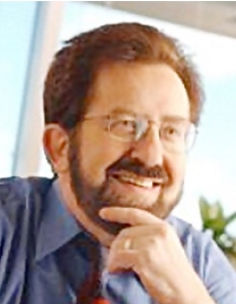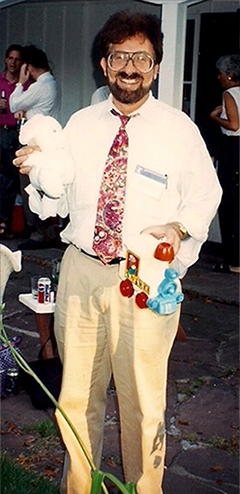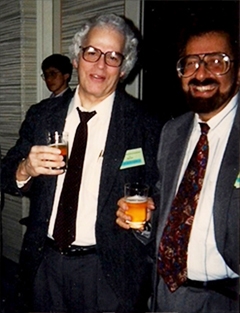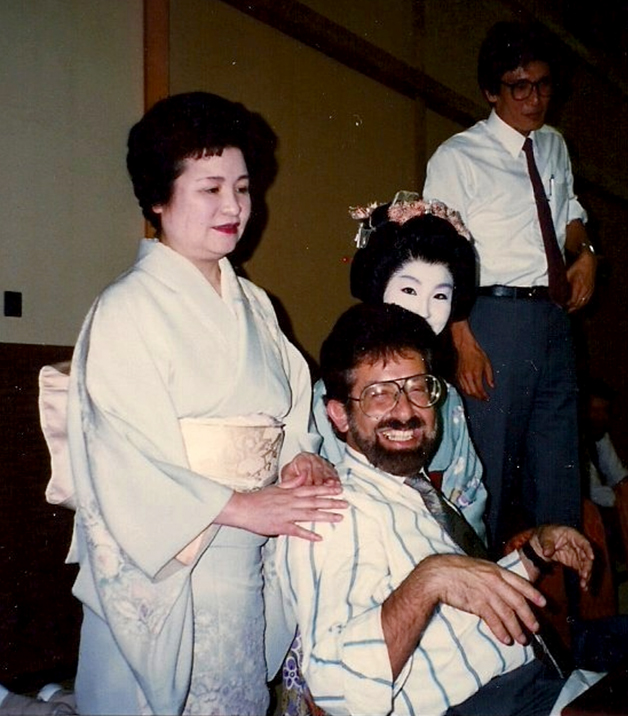Field Loses Another Pioneer with Passing of Allen Roses, 73
Quick Links
Even as the Alzheimer’s research community was reeling from the news of Dale Schenk’s untimely death, the next blow hit. Also on September 30, Allen Roses had passed away. Two titans struck down on the same day? Some might rightly suspect a tear in the universe last Friday.

Allen Roses
According to news reports, Roses, 73, had a heart attack. Roses worked at Duke University, Durham, North Carolina, and was CEO of Zinfandel Pharmaceuticals, which he founded.
While at Duke in 1993, Roses identified apolipoprotein E4 as a major genetic risk factor for late-onset AD (Stritmatter et al., 1993; Corder et al., 1993). Even though geneticists initially questioned this seminal work, as geneticists are wont to do, it was subsequently confirmed over and over again. Indeed, it opened a window onto AD pathogenesis.
Thousands of papers have since been published on the role of ApoE variants in AD, though a full understanding of ApoE’s role in AD eludes the field to this day. Even so, a large secondary prevention trial using ApoE4 genotype as a selection criteria is now underway (see Generations study).
Ironically, Roses, who famously had no fear of controversy, would later challenge his own finding. He claimed that the true risk allele on chromosome 19q13 was not ApoE4 itself, but the adjacent TOMM40 gene, which encodes a mitochondrial outer membrane protein. Discovering a variable length polyT region within an intron in Tomm40, Roses reported the longest variant to be associated with an earlier onset of AD and co-inherited with the ApoE4 allele (see Nov 2009 conference news). In further work, he tied the longer Tomm40 alleles to brain atrophy and cognitive decline (see Jul 2010 conference news), though other studies have not confirmed these associations (see Aug 2011 news).
After 10 years at GlaxoSmithKline (now GSK), Roses returned to Duke, where he continued to study the role of Tomm40 in AD. He was instrumental in establishing the global TOMMORROW trial, which will test if the Tomm40 long-T allele predicts conversion from mild cognitive impairment to AD, and if the diabetes drug pioglitazone can delay this progression (see Aug 2013 conference news). TOMMORROW receives funding from Takeda, maker of pioglitazone, and Zinfandel.
Alzforum invites friends and colleagues to raise a glass of nice red wine to Roses, then share their thoughts, memories, and stories by emailing gstrobel@alzforum.org.—Tom Fagan

At a meeting in 1994 he attended with his wife, Ann Saunders, and their two very young children, Allen Roses kept track of their toys as well as the science. [Courtesy of Carmela Abraham.]

At a conference in Japan in 1993 with Nobel laureate Stan Prusiner (left). [Courtesy of Carmela Abraham.]

Also in Japan, enjoying the geishas in 1989 … [Courtesy of Carmela Abraham.]
References
News Citations
- Dale Schenk, 59, Pioneer of Alzheimer’s Immunotherapy
- Las Vegas: AD, Risk, ApoE—Tomm40 No Tomfoolery
- Honolulu: Tomm40 Reported to Track With Brain Atrophy, Cognition
- Large Study Questions Tomm40’s Effect on AD Age of Onset
- Clinical Trials Roundup: Broadening the Lines of Attack
Therapeutics Citations
Paper Citations
- Strittmatter WJ, Saunders AM, Schmechel D, Pericak-Vance M, Enghild J, Salvesen GS, Roses AD. Apolipoprotein E: high-avidity binding to beta-amyloid and increased frequency of type 4 allele in late-onset familial Alzheimer disease. Proc Natl Acad Sci U S A. 1993 Mar 1;90(5):1977-81. PubMed.
- Corder EH, Saunders AM, Strittmatter WJ, Schmechel DE, Gaskell PC, Small GW, Roses AD, Haines JL, Pericak-Vance MA. Gene dose of apolipoprotein E type 4 allele and the risk of Alzheimer's disease in late onset families. Science. 1993 Aug 13;261(5123):921-3. PubMed.
Other Citations
External Citations
Further Reading
No Available Further Reading
Annotate
To make an annotation you must Login or Register.

Comments
Arizona Alzheimer's Consortium
Allen was a founding adviser to the Arizona Alzheimer’s Disease Core Center and Alzheimer’s Consortium. He was a pioneer in Alzheimer's and neuromuscular disease research, genetics, and related fields. It was his laboratory's discovery of APOE4, the major genetic risk factor, that led me to research, and it changed my life. He has always been there for us a colleague and adviser, and he was a dear friend.
Allen loved defying conventional wisdom. I valued his views, and his contrarian views most of all.
Allen was also particularly close with our steadfast adviser Zaven Khachaturian, who demonstrated the wisdom to launch the Duke ADC, recognizing the value of its rapid autopsy program and in anticipation of Duke’s groundbreaking APOE4 discovery.
His passing is a great loss to us in Arizona, and to the field.
MRC Laboratory of Molecular Biology
I first met Allen at the memorable Banbury Center conference on the molecular biology of Alzheimer’s disease organized by Tuck Finch and Peter Davies in 1988. We subsequently saw each other regularly at meetings, often with Ann Saunders, and became friends.
This was the heyday of the debates between Tauists and Baptists. After one of these heated exchanges, Allen advised me to read “The Art of War” by Sun Tzu.
We sometimes visited places together. I remember in particular a tour of the building in Berlin-Dahlem, which had housed the Kaiser-Wilhelm-Institut für Anthropologie, menschliche Erblehre und Eugenik.
When Allen was living in London, we often had dinner together, enjoying his trademark red wine. Allen was so full of life that it is hard to believe he has gone. He will always be remembered for his discovery that the e4 allele of the apolipoprotein E gene is the major risk factor for sporadic Alzheimer’s disease.
Center for Regenerative Medicine
I'd like to ask for reminiscences about the great debate at the SFN conference in 1995. It was the highlight of a decade of SFN meetings for me! Allen Roses and Dale Schenk on the same stage.
Here's an article about the debate on Alzheimer's etiology: http://www.the-scientist.com/?articles.view/articleNo/17606/title/Neuros...
Iowa State University; University of Iowa
I first met Allen at AAIC 2014 when I was still a postdoc. I had done preliminary work on the TOMM40 '523 poly-T story back in 2010. He was a larger-than-life figure to me, and I nearly did not have the gumption to approach him. I was delighted, however, that he found my work interesting. His encouragement partly prompted me to look into TOMM40 '523 again, where some new work was presented at AAIC 2016.
We had, along with Mike Lutz, just begun to develop a very productive collaboration. I am sad that I did not get to know him better. He was very kind to me and students in my new lab. He will be missed.
Medical University of South Carolina
Following up on Jeanne's request for reminiscences, I recall that Allen's discussion with song and dance was entertaining and informative. Steve Younkin was there, too.
I remember Dale showing a civil war picture and pointing to a gun and stating that it would be strange to speculate that the soldiers died of something other than a bullet, and someone in the audience replied that most people died of disease during the civil war.
I remember the first time I met Alan in the bus after his talk at SFN with a joke about the aluminum hypothesis. I asked him about the role of amyloid, and he shouted that amyloid was only a tombstone in AD pathogenesis and then said the same thing in his debate.
We will certainly miss his intellect and humor and will cherish his contributions to our field. It is indeed fitting that Guojun Bu, who contributed a lot of insight on APOE-mediated pathways following Allen's discovery, won this year's MetLife award.
Tel Aviv University
I first met Allen shortly after his seminal ApoE4 work was published, when he visited Tel Aviv University. Sitting on the beach, he expressed his opinion on my AD work at the time, stating that it was off the main focus of the field (he probably said it in harsher language) and that ApoE4 was the way to go. I followed his advice and am forever thankful for his vision and leadership.
I hope that in addition to acknowleding the gigantic magnitude of his findings, the AD field will now harness the effort needed to translate his research and ideas to AD therapy.
Allen was very direct, and interacting with him was both stimulating and challenging. I miss him.
Allen was a giant in our field. Not only did he contribute, among many other things, one of the most important discoveries of the past 50 years (APOE), but he was an iconoclast, ever challenging our assumptions and models.
Thomas Kuhn would have liked him. He taught and led by example, and I feel grateful to be a beneficiary of his wisdom. Our field is a little less strong with Allen gone, and speaking personally, I will miss him.
Boston University School of Medicine
When Jeanne Loring asked for comments on the 1995 debate, it brought up fond memories that characterized both Dale Schenk and Allen Roses. Allen was the consummate showman while Dale was the consummate gentleman with a wonderful sense of humor and humility.
Truthfully I remember almost nothing about what was said at the debate, just what the characters did. Specifically, as Allen came into the hall the music started blasting the theme song from “Rocky,” and Allen came prancing in wearing a black cape and clasping his hands over his head as if in provocative victory. I think Dale was already at the podium, and watched with a bemused smile on his face. The audience was hooting and hollering and clapping. The whole thing was hilarious.
What happened after that? Not so sure, except what I am sure of is that Allen's discovery about ApoE4 remains one of the most important genetic discoveries in the field of Alzheimer's disease and Dale's work at Athena/Elan produced an immense number of discoveries ultimately leading to immunotherapy for AD, which is perhaps the leading disease-modifying therapeutic for AD currently. Two titans of the field.
University of Glasgow
I first came into contact with Allen in 2010, when he had contributed genotyping of the TOMM40 "523" poly-T repeat in the Lothian Birth Cohort 1936, an aging cohort. He was interested to see if there was any role for poly-T repeat length in human aging, on things like brain structure or cognitive decline. My Ph.D. examined exactly that, and I therefore owe him enormously.
His enthusiasm for the research was striking and infectious. He had a really obvious passion for science, and was clearly full of life. I'd get emails asking "What about this approach?" or "Have you looked at that?" I certainly would not have guessed he was approaching 70 at that time! It is therefore doubly impressive that he was still publishing first-author papers into 2016.
Allen seemed a fun, interesting man and a great scientist, and I am saddened by his passing. My condolences to his friends and family.
Duke University School of Medicine
In his essay “Self-Reliance,” Ralph Waldo Emerson wrote, “To believe your own thought, to believe that what is true for you in your private heart is true for all men … that is genius … It is easy in the world to live after the world’s opinion; it is easy in solitude to live after our own; but the great [man] … in the midst of the crowd keeps with perfect sweetness the independence of solitude.”
As I worked with Allen and watched him in action, I often reflected on this essay, because until Allen joined GSK, where I was then employed, I had not met an individual who so closely reflected these ideals. All of us who knew and worked with Allen received so much—his generosity and kindness are as legendary as his love of good wine—but more than the encouragement and support, we also received a priceless education in how to live a great life. Be true to yourself; be honest; back up your words with actions. Don’t worry about your weaknesses; concentrate on your strengths; have faith in yourself. And have fun.
Allen daily put those words into action, as was our great fortune to witness. I missed the fuss the ApoE discovery created, but I did witness the reactions to the TOMM40 discovery. Understanding there is more to the chromosome 19 region than ApoE required great insight; the effort to learn what that is took creativity and courage. In the end, TOMM40 will be as accepted as ApoE, and stand testimony to Allen’s perspicacity as well as his willfulness, determination, and supreme confidence.
Even though Allen was irascible at times, largely his attitude during all this was one of calmness. Perhaps he gained this from art, another of his passions. Emerson also wrote, “Great works of art have no more affecting lesson for us than this: they teach us to abide by our spontaneous impression with good-humored inflexibility, most when the whole cry of voices is on the other side.”
Another lesson for me in Allen’s life was this: The man was indefatigable. “Lord, does the man never give up?” was Abraham Pais’ head-throbbing reaction to a paper by Einstein, who was the legendary elder statesman when he wrote it. I had the same reaction the last time I saw Allen in public. He and another colleague were presenting a joint departmental seminar. They’d planned for the other speaker to first present the statistical basis of a new approach the team is taking, and for Allen to then cover the genetical implications. But after a slide or two of statistics, Allen couldn’t sit still any longer and nudged the speaker off the floor. He spoke for the rest of the 60-plus minutes, explaining, explicating, answering questions with the patience of a seasoned teacher, and the enthusiasm of a new investigator. “He will never quit,” I thought. And he didn’t.
Banner Alzheimer's Institute
I first met Allen when he and I shared the stage in the 1990s for a regional update on Alzheimer’s disease not long after the ApoE4 risk story surfaced. After his talk, a woman in the audience asked if he knew his genotype. He spent five minutes regaling us all with one amusing personal anecdote after another, all with that deadpan expression and dry tone of his, at the end of which we barely noticed that he had not answered the question. But his point was clear: at that time, knowing your APOE4 profile didn’t tell you whether you would get Alzheimer’s disease, when, or what to do about it.
Now, about 25 years later, the answer to the last question has changed: If you are a cognitively unimpaired ApoE4 homozygote age 60-75, you can participate in the Generation Study, as the international Alzheimer’s Prevention Initiative ApoE4 trial is known. The study is one of Allen’s legacies. It is a public-private partnership funded by the National institute on Aging, philanthropy, Novartis, and Amgen, testing whether an active immunotherapy and/or a BACE inhibitor can stave off Alzheimer’s.
If we are lucky, one or even both of these therapies could work. Allen would have loved to criticize us for having done it somehow improperly while nonetheless giving us a private attaboy.
We miss his curmudgeonly love as well as his cadging to always do better, and we are forever grateful for the tremendous scientific advances that occurred by dint of his efforts.
Eisai
“Allen Roses is my uncle” was sometimes the first thing I would tell Alzheimer’s researchers soon after I met them, almost like a disclosure of sorts, since the research community had strong opinions about him (and vice versa!).
Over the course of my life, I have tried to learn from his advice, expertise, strengths and challenges. I will always draw inspiration from his commitment to Alzheimer’s research, which included fostering new ideas and creativity, developing novel means to fund research, and designing AD prevention studies. Allen also kept a keen focus on the professional development of his students, researchers, and colleagues.
I will leave it to others to chronicle his many achievements on these pages. He made it a point to live and work as if the current day might be his last, and it is bittersweet that I now say “Allen Roses was my uncle.”
Voyager Therapeutics
I first met Allen way back in 1976 while considering a residency in neurology at Duke. He was as brilliant, engaging, and provocative then as he was during our last meeting a few years ago.
I think Allen enjoyed being outside the mainstream scientifically despite the fact that his seminal discovery that the major ApoE alleles are powerful genetic risk factors for LOAD remains one of the most widely replicated and important findings in the field.
Shortly after this discovery, my lab reported that ApoE was critical to amyloid formation/deposition in PDAPP mice (Bales et al., 1997) and later, with Dave Holtzman (2000), we showed that ApoE4 markedly facilitates brain amyloid deposition/neuritic plaques (E4>E3>E2). Even though Allen's early genetic work was prompted by his and his colleague Warren Strittmatter's initial biochemical finding that ApoE bound to Aβ, and despite the fact that our mouse findings provided a very plausible hypothesis as to how ApoE4 might contribute to disease risk/pathogenesis, Allen remained unconvinced that ApoE had much to do with amyloid deposition and, for that matter, that amyloid had much to do with AD pathogenesis.
During several visits to Lilly, we energetically debated our respective findings and his more recent ideas on the possible therapeutic effects of TZDs in AD. Although we disagreed about most of this, I can honestly say I never enjoyed disagreeing with anyone more than I did Allen. He was a genuinely good and loving (and fun-loving) person and a true pioneer. I will always remember (and greatly miss) our conversations, his infectious smile and laughter, and his incredible humanity.
References:
Bales KR, Verina T, Dodel RC, Du Y, Altstiel L, Bender M, Hyslop P, Johnstone EM, Little SP, Cummins DJ, Piccardo P, Ghetti B, Paul SM. Lack of apolipoprotein E dramatically reduces amyloid beta-peptide deposition. Nat Genet. 1997 Nov;17(3):263-4. PubMed.
Holtzman DM, Bales KR, Tenkova T, Fagan AM, Parsadanian M, Sartorius LJ, Mackey B, Olney J, McKeel D, Wozniak D, Paul SM. Apolipoprotein E isoform-dependent amyloid deposition and neuritic degeneration in a mouse model of Alzheimer's disease. Proc Natl Acad Sci U S A. 2000 Mar 14;97(6):2892-7. PubMed.
Make a Comment
To make a comment you must login or register.